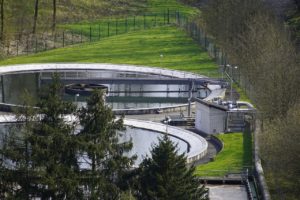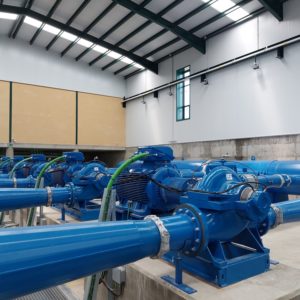Rockwell Automation Solutions Help on the Predictive Maintenance Strategy of Acciona Agua
In this area, the company manages integral services, from all the stages involved in water supply – making it suitable for human consumption – and the subsequent supply to the population, as well as urban and industrial waste water treatment.
The strategy of Acciona Agua is to keep the presence of the integral water cycle in Spain, Italy and Portugal. The organization has also started an international growth strategy, put into practice through the design and management of a full portfolio of efficient and flagship desalinization and water treatment plants in key areas such as India, Africa, Middle East, Southeast Asia, Australia and Latin America.
Challange:
One of the projects is in Morocco, where water resources do not meet the demand. In fact, water availability is about 720 m3/year per person, much lower than the hydric stress threshold of 1,000 m3/year per person. Forecasts for the next years are even worse, since the reduction to 520 m3/year per person. The main cause of this is the inefficient use of water resources in Morocco, increasingly higher levels of water pollution – mainly on the surface – and the increase of drinking water demand during the latest years due to population growth, urbanization rate and needs from rural areas, as well as the strong demand from industry, tourism and agriculture.
The main industry operator and distributor in Morocco is Office National de l’Electricite et de l’Eau (ONEE), which produces 80% of available drinking water. It was ONEE that commissioned Acciona Agua to design, construction and commissioning the Oum Azza Drinking Water Treatment Plant, in Rabat, along with the adjoining Raw Water Pumping Facility and the Power Substation. This treatment plant was built within the framework of a project to enhance the drinking water supply system to the coastal corridor that runs from Rabat to Casablanca, using water from the Sidi Mohamed Ben Abdellah reservoir.
For this purpose, Acciona Agua was assisted by Preditec, the engineering division of Grupo Álava, which specialises in instrumentation for protection, supervision and predictive diagnosis of machinery in industrial plants production reliability T&M, equipment and systems.
Preditec has supplied products and services to more than a thousand customers, with some 300 implementations of predictive plans made in the Iberian Peninsula and nearly 150 installations of continuous monitoring systems. In addition, he has worked on 30 projects outside of Spain in 18 different countries.
According to Arturo Burriel, Project Engineer at Preditec: “Our mission is to help our customers implement predictive strategies for industrial maintenance in order to improve plant reliability, increase safety, boost asset availability, remove unscheduled failures and reduce maintenance costs by means of advice, predictive diagnostics services, training and technology support.” Preditec has supplied products and services to more than one thousand customers, with about 300 predictive programs implemented in Spain and Portugal, along with 150 continuous monitoring systems.
The plant is designed to produce a nominal flow of 18,000 m3 / h or 432,000 m3 / day of water fit for human consumption. This water complies with all Moroccan and World Health Organization (WHO) quality requirements, so water pumps providing this service must work seamlessly. “The project managers wanted the raw water pumps vibration and temperature to be monitored, so if any of them exceeded previously established thresholds, the machinery would be shut down to avoid bigger issues and information on exactly what the problem is could be available to the maintenance engineers,” comments Burriel. High vibration or temperature levels are indicative of mechanical wear, so it’s convenient to shut them down before things get worse. “Sometimes,” says Burriel, “the issue can be solved by shutting it down on time, for example, simply changing bearings; if it is left running, repair costs could be much higher.”
These mid-voltage pumps, with a power of 2.7 MW, are critical for the facility since their task is carrying raw water from the Sidi Mohamed Ben Abdellah reservoir to the Drinking Water Treatment Plant after overcoming a slope of almost 100m along 5 km. In case of failure of the Drinking Water Treatment Plant, it has a raw water tank which allows it to operate for 10 minutes. This requires long downtimes to be avoided as a critical issue for this equipment.
Acciona Agua needed six water pump groups to be monitored, with five vibration measurements and six temperature measurements each. The Preditec proposal comprised two cabinets containing all the instruments and sensors installed to perform predictive maintenance tasks for three water pumps each. The overall solution was based on an Integrated Architecture solution from Rockwell Automation.
Solution
The cornerstone of the monitoring system installed in each cabinet supplied by Preditec are Allen-Bradley CompactLogix programmable automation controllers, which integrate safety up to SIL 3.
Data is gathered by four Dynamix 1444 vibration and temperature monitoring modules. These modules measure and monitor a set of critical parameters in the machine with the accuracy, reliability and performance required by industrial standards. They also support Device Level Ring with dual-port EtherNet/IP communications and are seamlessly implemented within the Integrated Architecture system.
These are joined by Allen-Bradley POINT I/O 1734 modules with PT100 input modules and relay outputs in each cabinet. Both comply with safety standards and provide full machinery diagnostics. Burriel states that “thanks to this combination of components, the system achieves high flexibility to control vibrations and temperatures, as well as triggering relays when necessary.”
Preditec also used Rockwell Automation‘s engineering environment, Studio 5000®, an integrated and scalable development framework that offers multiple capabilities, and allows Acciona Agua’s engineers, operators and technicians easy access to data gathered in the Integrated Architecture system, improving its development efficiency, and reducing programming errors.
Results
Burriel explains: “With Rockwell Automation Integrated Architecture based around CompactLogix, Dynamix 1444 and Point I/O connected through EtherNet/IP, we provided a competitive solution to Acciona, delivering optimal vibration and temperature measurement. This helps the customer to take decisions quickly to protect their machinery properly.”
An additional advantage of these systems implemented in Preditec cabinets is that they comply with specific safety standards relating to vibration and temperature. “This,” Burriel concludes, “gives peace of mind to Acciona Agua”, since it “helps deliver the correct operation of the facility.”
Source: AC Engineering







